 |
||
|
||
| ||
TABLE OF CONTENTS
Something happened on the 22nd of June that contributed to the launch of the new product from NVIDIA, namely the GeForce 7800 GTX. I have already written about the birthday party, organized by high officials of the American company. We have already reviewed the main aspects of the new product. I hope our readers have already read the article written by our several authors. What was left off screen of that analysis? Of course, as it often happens, we find new aspects of a new product in the course of time. In this case, we have found some details not even on the units of the G70 GPU, but on their frequencies. Our readers should understand that for the first six months after the launch of the GeForce 7800 GTX, all video cards based on this GPU and sold by NVIDIA partners will be reference cards. That is, as in case of the ATI RADEON X850XT, all video cards are manufactured in one place (maybe even on two or three plants) ordered by the chip maker (NVIDIA or ATI), while the partners just buy ready cards. Then they stick their labels, probably replace covers on the cooling systems (if they had been ordered by the partners), the cards are then packed into bright (or dull) boxes and go out to stores. It turns out that testers and reviewers have nothing much to do, as all these cards are twins. But what's so different about distressful Gainward from other NVIDIA's partners (I'll tell you why it's distressful later)... Well, it has a special series - Golden Sample. It includes products that passed thorough tests of specialists from this company in order to find out whether they can operate at increased frequencies. The objective of Golden Sample is to select products within an entire series, which can certainly work faster (if frequencies are higher, performance is also higher - that's a law). Of course, it all has an effect on product costs. So prices for video cards from this series are a tad higher (though they are sometimes lower than those for popularity flagships, say, ASUS). I have a question: but what happens with video cards that failed the Golden Sample tests? What if there are much more "rejects" than the qualified cards, and only GS cards are in demand? We have already seen such a situation in 1999 with Hercules cards. Where is this company now? - It's dead. Only its brand is preserved as part of French Guillemot, which currently has nothing to do with video cards. Why? - Because of the boom of Riva TNT2 Ultra with increased clocking, even despite raised prices, while regular TNT2 cards (as well as rejected TNT2 Ultra) were getting dusty in storehouses and the company's debts were plummeting. As a result, only a couple of TNT2 Ultra cards can still be found in Moscow (one of them is in the museum of yours truly), the company had gone bankrupt. That's where the distressful thing starts. As fate has willed, the cause of exclusive cards has not become a thing of the past, but has been taken up by Gainward. As a result appeared Golden Sample, which also offered products capable of operating at higher frequencies (guaranteed by the company). But a lot of amendments were made. The main mistake, made by Hercules, was not to sell regular TNT2 Ultra at attractive prices, just overclocked cards (which were in the minority because of the 0.25 micron process technology). For some unknown reason, all the rejects went to the TNT2 series. That is the range of cards should have been enlarged. Besides, services and marketing of the company were just awful. That was all improved in Gainward and GS. Increased frequencies were not specified in BIOS, only ExperTool granted access to these settings (it was a concession to NVIDIA, who demanded not to meddle with reference clocking). Besides GS, there was also a regular line of cards at lower prices, so the choice was rather wide. However, even these steps did not bring financial success to Gainward, on the contrary, its debts were piling up... And for some reason, those responsible for this situation were gaining more power in the company. As a result, this private company faced the bankruptcy problem, which must have been avoided at all costs, considering its huge OEM and outsourcing output (aside from manufacturing products under its own brand). There appeared rumours in Internet that someone bought this company or just its brand, etc. This entire scrape certainly affected the prestige of this company and popularity of its products on the market. What concerns the Russian market, our experienced readers may remember the spiralling popularity of Gainward in 2001, when GeForce3 was launched. Video cards from this brand were of the same high quality as Leadtek products (I can still recommend Leadtek or Gainward cards for their excellent 2D quality even to super capricious owners of huge monitors). But the untalented marketing policy of the company resulted in its oblivion up to recently. Dealers, appointed from Germany, worked in a slipshod manner, test samples were scarce, and the interest to this brand finally expired. However, we should do justice to the new management of the company that had been formed before the latest events, when the company joined a powerful financial holding. Finally the Russian market was estimated at its true worth, a small representative office opened in Moscow. This tiny staff currently faces an immense task: to return the brand to the market and to prove that Gainward is not dead. New Gainward management (by the way, the headquarters are now in Munich) has set to work ardently (a new broom sweeps clean) and positions of the Moscow office were weak, but still the brave employees convinced their boss of peculiarities of our market and showed its promising nature. I can only express my hope that it's not in vain and Gainward's share of the market will grow. So, let's get back to GS. The series survived the scrape. Moreover, GeForce 7800 GTX even got farther: increased frequencies are written in BIOS, that is you don't have to install ExperTool. There is still one disappointment (though Gainward employees in Moscow are already sobbing as they hear my words, repeated for the thousandth time): Golden Sample should have been marked out either with PCB color (It must be Golden Sample for a reason!) or with a special box and bundle. GS sticker on the card and a proper label on the box (which hasn't been redesigned for many years!) - it's not enough to help users (especially novices) to distinguish this series among other models. Let's return to our card. Now almost all articles will include video clips, which will be brief but more illustrious concerning a new product. There will be three formats: the best quality (MPEG1), average and low quality (WMV). So,
In conclusion I want to say that we shall analyze new aspects of core operation by the example of this GeForce 7800 GTX, assuming that it has at least three frequencies (or even more) instead of only one. Video card
As I have already said, all G70 cards are as like as two peas. Here is a copy of the reference card, which is no different from the one we reviewed in the base article.
The product has VIVO, where VideoIn is based on Philips 7115. The whole last year we were surprised why the entire GeForce 6800 series was not equipped with such coders, though PCBs provided empty seats for them. Nobody could explain why none of NVIDIA's partners installed such a chip on its cards. There probably were some layout defects. And now a video input is good news.
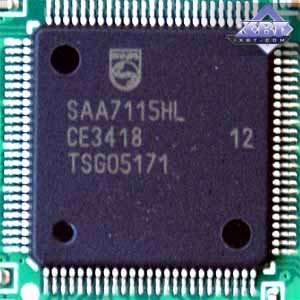 We should also mention that the card is equipped with a couple of DVI connectors.
The card is equipped with GPU GeForce 7800 GTX:
Note that the processor is manufactured on Week 20 of this year, that is in May. It's another proof that G70 (the former NV47) was ready long ago (the designation marked in May was real, not just a code). Its announcement was delayed only for marketing reasons (to give the green light to GeForce 6800GT/Ultra).
Bundle
Box.
Installation and DriversTestbed configurations:
VSync is disabled. A story about the triple core frequencies
Here is a screenshot of the driver control panel that declares the nominal frequency of this card in 3D:
 Everything is OK, as promised, it's 470/1300 MHz. However, when I tested a reference card, I paid attention that RivaTuner (written by A. Nikolaychuk AKA Unwinder) demonstrated a slightly different frequency, approximately by 40 MHz higher than the nominal, (the reference frequency - 430 MHz + 40 = 470 MHz). The fact is that this utility detected the maximum value of the clocking. Together with the author of this utility we got down to the analysis and tested the card at 5 MHz higher and lower than the nominal, constantly reading the report from chip registers. We found out that it actually has THREE FREQUENCIES. There has appeared information in Internet that NVIDIA unofficially mentions more frequencies, that the entire GPU consists of many units, each one potentially being able to operate at its own frequency. It gets hard to understand which one to take as the base frequency, what to write on the boxes, etc. It's logical to take for it the frequency of the rasterizer, pixel pipelines. But even this unit is not indivisible. We already have ROP and Shader unit. So, this issue is still unclear. But as frequencies of BOTH units are currently equal, this very frequency is taken for the reference. And this very frequency is declared as 430 MHz in the reference card and as 470 MHz in this card from Gainward. But what is this above mentioned frequency, increased by 40 MHz? - It's clocking of the geometry unit. As it currently consists of vertex pipelines, we can say that Vertex pipes operate at 468 MHz (declared as 470 MHz). Right after the G70 was launched, ASUS announced that its card would operate at this very frequency. I haven't examined this product yet. But I can assume that having heard about various GPU frequencies from engineers, marketing specialists decided to use this point and published the geometry unit frequency (470 MHz) as the base one. Their SmartDoctor utility would declare this very value, like RivaTuner 15.6 that had been released earlier. I repeat, it's only my assumption, they could have just as well modified the base frequency, like Gainward.
So, what's the base frequency? As we understand, there are THREE units that can potentially have different frequencies: ROP, Shader Unit, Vertex Unit. Alexei Nikolaychuk has already fixed all the three parameters in his new Version 15.7, which will soon be out:
 Note that all the three units operate at the same frequency of 275 MHz in 2D mode. When 3D mode is enabled (you can see it well in our video clip at the link above), the frequency grows to the level... Let's see to what level it grows. The geometry unit operates at the frequency specified by BIOS (470 MHz) plus another 40 MHz = 510 MHz. But the other two units have grown up to 459 MHz, nothing of the 470 MHz.
According to our tests, the frequencies of ROP and Shader Unit are modified, firstly, by the driver synchronously to the geometry unit. They cannot be changed separately (the driver shall specify its own value anyway); secondly, they are changed at 27 MHz steps! The card has a 27 MHz crystal oscillator and the driver uses multipliers to set the operating frequency of the chip. In our case it looks like this: That's how we get these very 432 MHz (declared as 430) in the reference card. Further frequency growth can be only 459, 486, 513, etc. MHz. These two units cannot possibly have 470 MHz so far. I repeat, it's up to the driver, its later versions may have changes. So, the driver "determines" which of the above mentioned frequencies are closer to the value specified in the control panel (or BIOS) and sets either 432 or 459. 470 MHz are closer to 459 than to 486, that's why monitoring shows 459 MHz. This card actually operates at 459/1300 MHz, while its geometry unit runs at 510 MHz. Since GeForce FX, high end cards have THREE operating modes: 3D High Power, 3D Low Power, and 2D. There was no medium mode in NVIDIA driver settings, it could be selected only in RivaTuner.
These three modes exist even now. 3D Low Power is engaged when you quit a 3D application.
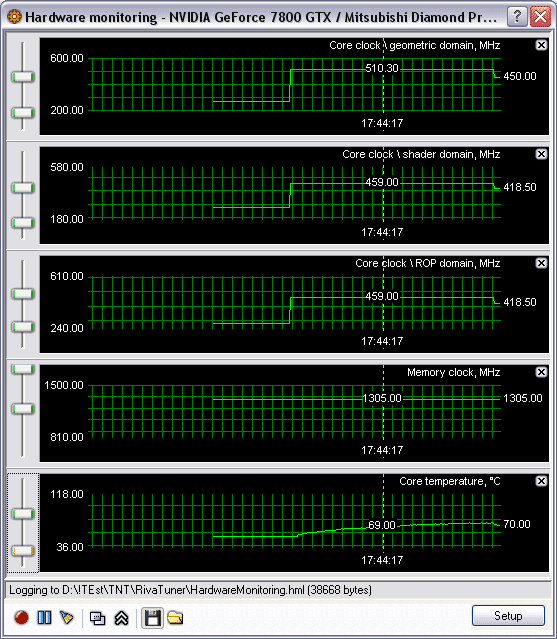
As you can see, the system doesn't jump back to 275 MHz in 2D immediately. At first the frequency goes down to 418 MHz (3D Low Power) for 3-5 seconds. The driver uses other multipliers to get this frequency:
It indicates that the driver can potentially use different multipliers, so the 27 MHz step may be retained or may be not. Now what concerns overclocking. Some mass media take pleasure to declare the core overclocking to 520 and 530 MHz, not suspecting that the core can actually operate either at 486 MHz, or 513 MHz, or 540 MHz. The last frequency is hardly attainable. Only the geometry unit will obey the settings specified by a tester. If the 27 MHz step survives, we shall analyze the effect of flexibility of the Vertex Unit frequency in case of invariable or little changed frequencies of the base unit. It's clear that the frequency of the geometry unit can be changed within 13 MHz, when the main units stay at their old frequency.
So, overclocking. I guess there is no need to explain one more time that there is no point in setting the frequency higher than 513 MHz. So it has been selected. Here are temperature readings of the operating core (NO ADDITIONAL COOLING!):
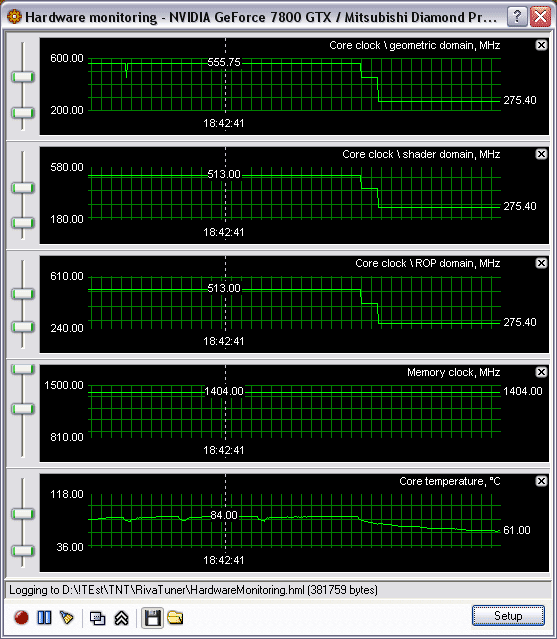 Memory was overclocked to 1400 MHz. We can see that it's the maximum frequency for the core: artifacts appear at the end of the test block. The lower frequency is only 486 MHz. If the main part of the GPU could have operated at 505 MHz, it would have been the maximum overclocked mode (stable, without additional cooling) for this sample. Thus, we have found out about three GPU units, which have potentially different operating frequencies. But the driver keeps them in batch mode. The only exception is that the geometry unit frequency can be changed flexibly (it has its own multipliers), while frequencies of ROP/Shader Units can be changed at 27 MHz steps. We can change the frequency of the geometry unit within half of this step, given the frequency of ROP/Shader Units is unchanged. We have also determined that the operating frequency of Vertex Unit is always higher by the same value, specified by BIOS (+40 MHz). The work is not completed - according to some NVIDIA employees, the core have more than three units operating at different frequencies. But you should understand this: we cannot speak of A CHIP OPERATING AT A GIVEN FREQUENCY anymore. To be more exact, we can speak of it only CONVENTIONALLY, taking for the reference point the operating frequency either of ROP or of Shader Unit, as they exert the most influence on the resulting performance. Test results: performance comparisonWe used the following test applications:
Game tests that heavily load pixel shaders 2.0.TR:AoD, Paris5_4 DEMO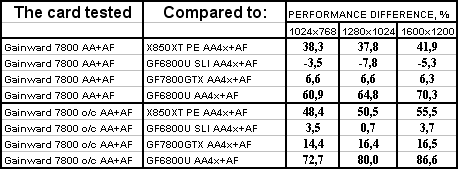 We use this outdated and not very popular game as an example of a classic "shader game", which heavily loads these units. We can see that only a heavily overclocked card based on the 7800 GTX managed to outperform the 6800 ultra SLI. But in other respects and at standard frequencies, the breakaway from competitors is rather significant.
Game tests that heavily load vertex shaders, mixed pixel shaders 1.1 and 2.0, active multitexturing.FarCry, Research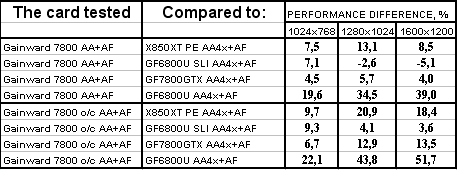 FarCry, Regulator
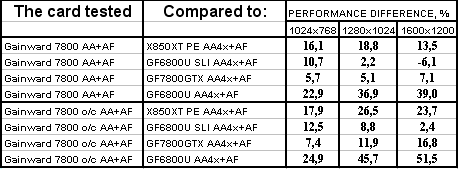 FarCry, Pier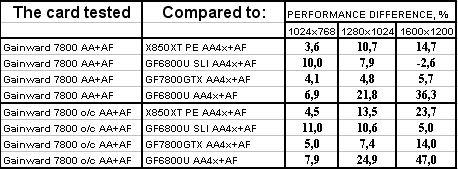 It's interesting to note that the card from Gainward even at its standard frequencies is almost always faster than the 6800 Ultra SLI. To say nothing about overclocking. Its victory over competitors (conventional, of course!) is impressive. F.E.A.R. (MP beta)
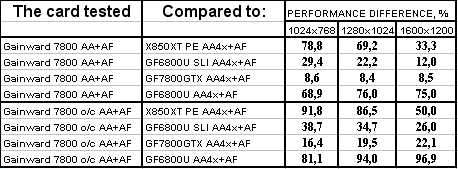 F.E.A.R. is the latest game, its release is planned for the autumn this year. It loads accelerators heavily, so the results are not so high in absolute FPS with maximum quality. We can see that the 7800GTX has heavily outperformed its predecessors, even the 6800 Ultra SLI paled into insignificance. The X850XT PE has become an outsider, however paradoxical it sounds for a $500 card. That's actually the minimum required by this game in maximum quality settings.
Game tests that heavily load both vertex shaders and pixel shaders 2.0Half-Life2: ixbt01 demo
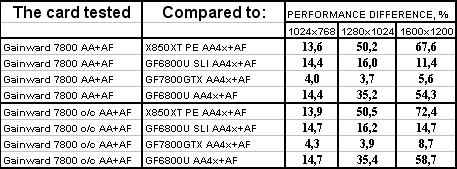 Half-Life2: ixbt02 demo
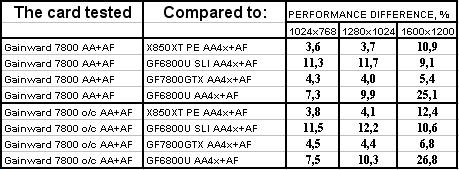 Half-Life2: ixbt03 demo
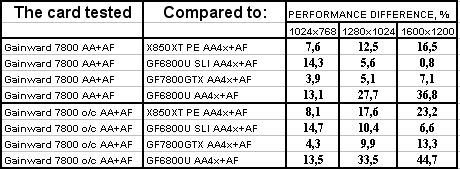 I guess, the leadership of the product from Gainward is evident. This accelerator also outperforms the former top video cards, even the 6800U SLI pales into insignificance. .
Game tests that heavily load pixel pipelines with texturing, active operations of the stencil buffer and shader unitsDOOM III High mode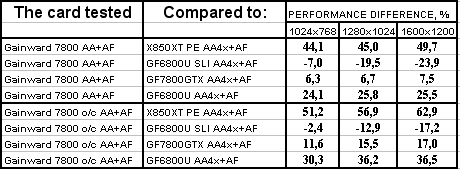 Chronicles of Riddick, demo 44
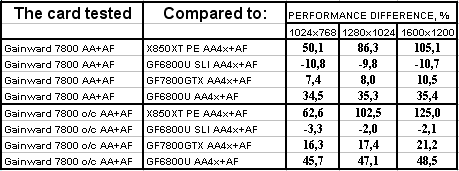 Chronicles of Riddick, demo ducche
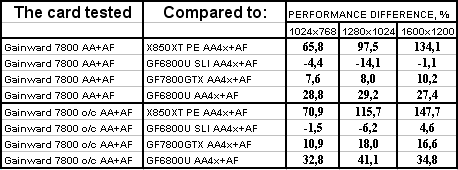 Interestingly, video cards with higher fill rates (the 6800 Ultra SLI) are still victorious, where applications require calculating power to provide more pixels per second. However, there are no reasons to be upset, because this tandem costs dearly, thus the 7800 GTX is at advantage.
Synthetic tests that heavily load shader units3DMark05: MARKS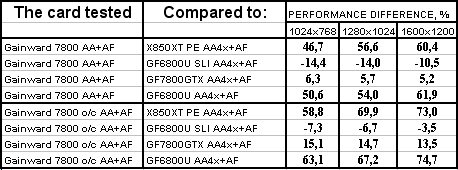 The results are similar to those in TR;AoD, where everything is up to the capacity of shader units. Of course, the total of 32 pipelines and 32 ROPs in the 6800 Ultra SLI have done their part and drivers for this package are already finetuned. That's why even the overclocked 7800 GTX takes only the second place. However, note the previous point: prices for the 6800U SLI are currently too high to call it a good bargain (unless you already own the 6800U, and the second card will be your birthday present :-) ).
ConclusionsSo: Gainward Ultra 3500PCX XP Golden Sample 256MB is currently (so far!) the best choice among GeForce 7800 GTX (if its prices are not too high). Even though it's a complete copy of the reference design, this product features increased clocking and increased operating stability. But it's high time that the company should distinguish these super expensive cards versus common models: better boxes, bundles, and even design of the accelerator. This video card is very stable, 2D quality in this sample is up to the mark: 1600x1200@100Hz - excellent sharpness.
You can find more detailed comparisons of various video cards in our 3Didest.
Theoretical materials and reviews of video cards, which concern functional properties of the GPU ATI RADEON X800 (R420)/X850 (R480)/X700 (RV410) and NVIDIA GeForce 6800 (NV40/45)/6600 (NV43)
Write a comment below. No registration needed!
|
Platform · Video · Multimedia · Mobile · Other || About us & Privacy policy · Twitter · Facebook Copyright © Byrds Research & Publishing, Ltd., 1997–2011. All rights reserved. | |||||||||||||||||||||||||||||||||||||||||||||||||||||||||